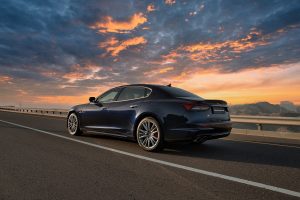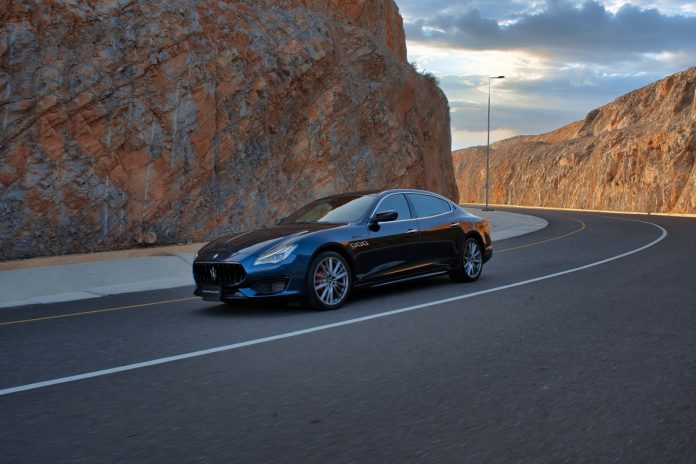Muscat: Experiencing luxury the Italian way is one off the checklist! Alfardan Motors had a splendid evening planned for journalists in Oman giving them the taste of a classic Italian Opera Night at ROHM along with an exclusive test drive for the weekend in their exquisite fleet.
OERLive’s editor Swathi Suresh drove the Maserati Quattroporte. Here is everything you need to know about this beauty on wheels:
Maserati has introduced new and exclusive trim levels for the Quattroporte, to celebrate the refresh of the range with the Model Year 22 (MY22).
The three new trim levels – GT, Modena (also available in Q4 version) and Trofeo – have been developed not only to meet all customers’ requirements and expectations, but also to epitomise the various over-arching themes of the Maserati range: innovation, performance and design.
From a stylistic point of view, the three new trim levels (GT, Modena and Trofeo) feature the new Maserati logo on the bonnet (included in the range from the MC20 onwards), new Trident logo on the C-pillar and refreshed lettering on the rear. There is also a specific trim level badge (bearing the wording “GT”, “Modena” or “Trofeo”) on the sides, just above the three iconic air intakes.
The new Maserati lettering appears on the central screen as well, as does the new “Trofeo” logo on the headrests.
A classic example of true Italian design, the Quattroporte expertly combines elegance and sportiness. With MY22, the Brand’s DNA is thus expressed in unique proposals, the result of the synergy that has played out between the Centro Stile Maserati and the Product Development Team, on research into materials, design cues and dedicated features.
In its 55 years of history, the Quattroporte’s style has evolved in the wake of the creativity of the best Italian designers. In 1963, the first Quattroporte combined performance, style and luxury in an elegant body designed by Pietro Frua, bringing to life a new market segment: luxury sport sedans.
The 1974 second generation – created by Bertone and deliberately produced in very limited numbers – was followed by the great success of the 1979 Quattroporte, designed by Giorgetto Giugiaro. In turn in 1994, Marcello Gandini redefined the fourth series of the flagship according to more compact style canons, whilst Pininfarina’s 2003 Quattroporte set a new design standard for the segment, becoming a benchmark in the class for almost a decade.
An outstanding Cx of 0.28
The new Quattroporte is reconfirmed as a car with as original and exclusive a personality as its forerunners. The bold, imposing nose is sculpted around the 3D grille inspired by the Alfieri concept car: tapered and majestic, it features vertical chrome-plated elements in contrast with the depth of the “sharknose” effect. Making an appearance in the grille is the tuning fork, a design cue introduced with the MY21.
Most of the aerodynamic interventions on the Quattroporte over time cannot be seen, having been made on the lower part of the car. The flat bottom has various aerodynamic features, including a NACA duct to cool the differential without increasing aerodynamic drag, and deflectors on the rear suspension arms to conduct the airflows effectively.
The classic Maserati grille has evolved into a functional, actively aerodynamic component, with the inclusion of an electrically adjustable air shutter between the air vents and the engine radiator. With the air shutter’s perfect calibration of the engine temperature and optimisation of the car’s aerodynamics by reducing fuel consumption and CO2 emissions, the Quattroporte now has an exceptional Cx of 0.28.
Adaptive Full-LED headlights
Adaptive Full-LED headlights come as standard on all Quattroporte versions in both the high- and low-beam headlights, the daytime running lights (DRLs), parking lights and direction indicators. Equipped with static bending light and automatic adjustment of the light beam height, these headlights are notable for the horizontal geometry of the DRLs, the form of which is reminiscent of the triple air intake above the car’s fenders.
The headlights include a built-in front-facing camera to support the Bi-Led Glarefree function for adaptive high beam adjustment. This feature creates “tunnels” of light by reducing the light beam in areas around the car that can be left in the dark, so the driver can always keep the high beams on without worrying about bothering drivers proceeding in the opposite direction.
The headlights also interact with various car parameters to activate one of the following lighting modes: “urban” (<50 km/h), “out-of-town” (50-110 km/h), “motorway” (>110 km/h) and “rain”.
The boomerang taillights recall the Trident brand’s history and were introduced with the MY21, including on the Quattroporte.
Highly elegant interior
“Full-Grain” natural leather is available for the elegant interior of the Quattroporte.
The long wheelbase of the latest-generation Quattroporte has resulted in a huge increase in space inside the elegant passenger compartment, recreating the environment of an exclusive high-class living room for the driver and passengers.
The tapered and enveloping forms of the interior give the dashboard and tunnel a feeling of great lightness. To emphasise the refined character of the Quattroporte, the entire surface of the dashboard is covered with a selection of prestigious, exclusive finishes, combined with decorative accents on the front and rear door panels.
The cabin is structured around a simple and user-friendly interface. The instrument cluster includes a large analogue tachymeter and speedometer, alongside a 7” TFT display for the car’s operating functions. The height and depth of the leather steering wheel can be adjusted electronically.
The MY22 Maserati Touch Control Plus (MTC Plus) infotelematics system features a high-resolution 8.4” capacitive touchscreen display with updated graphics and improved climate control functions. The dual rotary selector made of forged aluminium offers intuitive adjustment of the audio volume and other functions.
On the MY22, the centre console features a redesigned gear lever and a new version of the push-button panel for driving modes, as well as two extra large cup holders as specifically requested for the American market*, available as an option but as standard on cars destined for the USA and Canada.
The three rear seats are spacious and comfortable, with excellent legroom.
The rear armrest has a USB port to charge mobile devices and two retractable cup holders. An ashtray is now available as an option for the door panel. The rear seats include ISOFIX attachments for child seats.
The lighting system uses optical fibres that run along the dashboard and doors as well as in the handle cavities and pockets of the doors themselves, to give the interior a modern and classy look. The ergonomic ceiling light includes a button to open the tailgate and the parking sensors control, located to the right of the panoramic roof controls.
The front and rear ceiling lights are equipped with diffuse lighting and two separate reading lights, as well as two built-in LEDs that emit a soft light for the area below; the footwell is also illuminated.
The cabin of the Quattroporte includes a mobile phone holder, three 12V electrical outlets, a USB charging port in the rear armrest and various illuminated and air-conditioned compartments: two in the lower section of the dashboard (a glove compartment on the passenger side, another on the driver’s side) and a further one in the large front armrest. The touchscreen display menu includes Valet* mode, to electrically lock the passenger glove compartment. In this mode, the compartment can only be accessed by entering a four-digit PIN.
The rear seats are modular in a 60:40 ratio: the smaller section can be folded down to load longer items into the 530-litre boot.
Also available is the Quattroporte Modena Q4 version with all-wheel drive, again powered by the 430-hp V6.
The V6 engines in the Quattroporte Modena and Modena Q4 deliver 430 hp of power with peak torque of 580 Nm from 2,250 to 4,000 rpm. The engine’s maximum rev count is 6,500 rpm.
The 3.0-litre twin-turbo V6 engine shares most of its key components with the V8: it has the same bore, the same variable valve timing technology, and almost the same turbocharger, manifold and monoblock technology. This engine is equipped with high-turbulence cylinder heads and four cam phasers. With two continuous cam phasers for each cylinder head, it can anticipate or delay the timing of the intake and exhaust valves, independently and in real time.
Like the V8, it uses an ECU control unit with built-in high-speed processors, which manage a variety of functions in real time. Maserati Powertrain has also made use of on-demand peripherals such as the variable-flow oil pump, operated electrically to improve fuel consumption and performance.
The V6 also uses innovative computer control that monitors the car’s electricity consumption and manages the alternator load accordingly.
However, the 60° layout rather than 90° makes the V6 an engine with a character all of its own. This engine’s power and peak torque are slightly higher than the 3.8-litre V8 engine’s, at 144 hp/L and 194 Nm/L respectively (compared to the V8’s 139 hp/L and 187 Nm/L with overboost).
Acceleration from 0 to 100 km/h takes only 4.8 seconds in the Quattroporte Modena Q4 and 5.0 seconds in the Quattroporte Modena. The top speed of both models is 288 km/h.
According to data from the Worldwide Harmonised Light Vehicle Test Procedure (WLTP) – a more accurate reflection of real-world driving conditions, the fuel consumption and CO2 emissions of the Quattroporte Modena Q4 are 11.2-11.6 L/100 km and 253-263 g/km respectively.

The Modena trim level emphasises its athletic features, with sporty bumpers, Piano Black accents and 20” alloy wheels.
In the cabin, every detail is reminiscent of the driving pleasure typical of the Brand, with the enveloping leather sports seats and Piano Black Trim interior.






